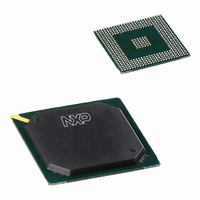PNX1502E,557 NXP Semiconductors, PNX1502E,557 Datasheet - Page 340

PNX1502E,557
Manufacturer Part Number
PNX1502E,557
Description
IC MEDIA PROC 300MHZ 456-BGA
Manufacturer
NXP Semiconductors
Specifications of PNX1502E,557
Applications
Multimedia
Core Processor
TriMedia
Controller Series
Nexperia
Interface
I²C, 2-Wire Serial
Number Of I /o
61
Voltage - Supply
1.23 V ~ 1.37 V
Operating Temperature
0°C ~ 85°C
Mounting Type
Surface Mount
Package / Case
456-BGA
Lead Free Status / RoHS Status
Lead free / RoHS Compliant
Program Memory Type
-
Ram Size
-
Lead Free Status / Rohs Status
Not Compliant
Other names
935274744557
PNX1502E
PNX1502E
PNX1502E
PNX1502E
Available stocks
Company
Part Number
Manufacturer
Quantity
Price
Company:
Part Number:
PNX1502E,557
Manufacturer:
NXP Semiconductors
Quantity:
10 000
- Current page: 340 of 828
- Download datasheet (8Mb)
Philips Semiconductors
Volume 1 of 1
Table 9: Register Description
PNX15XX_SER_3
Product data sheet
Bit
12:0
Offset 0x06 5084
31:13
12:0
Offset 0x06 5088
31:4
3:0
Offset 0x06 50C0
31:4
3:0
Offset 0x06 50C4
31:4
3:0
Offset 0x06 50D0
31:4
Symbol
MR
Unused
EMR
Unused
PRECHARGE_BIT
Unused
ROW_WIDTH
Unused
COLUMN_WIDTH
Unused
DDR_EMR
DDR_PRECHARGE_BIT
RANK0_ROW_WIDTH
RANK0_COLUMN_WIDTH
RANK1_ROW_WIDTH
Access Value
R/W
R
R/W
R
R/W
R
R/W
R
R/W
R
0x043
-
0x000
-
0xa
-
0xd
-
0xa
-
Rev. 3 — 17 March 2006
Description
Mode register. The assumption is the DLL reset bit is at location 8.
Use the datasheet of the DDR memory to determine the value of
this register. The reset value of this register represents a CAS
latency of 3.0 cycles, and a burst length of 8. Make sure to select a
burst size of 8, and a sequential burst type to ensure correct
IP_2031 operation.
The following is taken from a DDR datasheet and describes the
different bits of the mode register.
Bits 0 up to 2: burst length
Bit 3: burst type (‘0’: sequential, ‘1’: interleaved)
Bits 4 up to 6: CAS latency
Bits 7 and up: operating mode (‘0’: normal operation, ‘2’: normal
operation/reset DLL)
These bits should be ignored when read, and written as 0s.
Extended Mode Register. Use the datasheet of the DDR memory to
determine the value of this register.
For emulation purposes it may be required to disable the DLL. To
this end, make sure that bit 0 of this register contains a ‘1’. In normal
(non-emulation) mode, make sure that bit 0 of this register contains
a ‘0’.
The following is taken from a DDR datasheet and describes the
different bits of the extended mode register.
Bit 0: DLL (‘0’: enable, ‘1’: disable).
Bit 1: drive strength (‘0’: normal, ‘1’: reduced)
Bit 2: QFC mode
Bits 3 and up: operating mode
These bits should be ignored when read, and written as 0s.
Column bit responsible for precharge. Only the values 0x8 (bit 8)
and 0xa (bit 10) are supported.
These bits should be ignored when read, and written as 0s.
Row dimension: 2^ROW_WIDTH rows i.e., a value of 0xC specifies
2^12 = 4096 rows. Only the following values are supported:
0x8, 0x9, 0xa, 0xb, 0xc, and 0xd (supporting 256 up to 8192 rows).
These bits should be ignored when read, and written as 0s.
Column dimension: 2^COLUMN_WIDTH columns (each column
has a width of 32 bit). I.e., a value of 0xa specifies 2^10 = 1024
columns of 32 bit each. Only the following values are supported:
0x8, 0x9, 0xa, and 0xb (supporting 256 up to 2048 columns).
These bits should be ignored when read, and written as 0s.
© Koninklijke Philips Electronics N.V. 2006. All rights reserved.
Chapter 9: DDR Controller
PNX15xx Series
9-27
Related parts for PNX1502E,557
Image
Part Number
Description
Manufacturer
Datasheet
Request
R
Part Number:
Description:
Digital Signal Processors & Controllers (DSP, DSC) MEDIA PROCESSOR PNX15XX/300MHZ
Manufacturer:
NXP Semiconductors

Part Number:
Description:
IC MEDIA PROC 300MHZ 456-BGA
Manufacturer:
NXP Semiconductors
Datasheet:
Part Number:
Description:
NXP Semiconductors designed the LPC2420/2460 microcontroller around a 16-bit/32-bitARM7TDMI-S CPU core with real-time debug interfaces that include both JTAG andembedded trace
Manufacturer:
NXP Semiconductors
Datasheet:

Part Number:
Description:
NXP Semiconductors designed the LPC2458 microcontroller around a 16-bit/32-bitARM7TDMI-S CPU core with real-time debug interfaces that include both JTAG andembedded trace
Manufacturer:
NXP Semiconductors
Datasheet:
Part Number:
Description:
NXP Semiconductors designed the LPC2468 microcontroller around a 16-bit/32-bitARM7TDMI-S CPU core with real-time debug interfaces that include both JTAG andembedded trace
Manufacturer:
NXP Semiconductors
Datasheet:
Part Number:
Description:
NXP Semiconductors designed the LPC2470 microcontroller, powered by theARM7TDMI-S core, to be a highly integrated microcontroller for a wide range ofapplications that require advanced communications and high quality graphic displays
Manufacturer:
NXP Semiconductors
Datasheet:
Part Number:
Description:
NXP Semiconductors designed the LPC2478 microcontroller, powered by theARM7TDMI-S core, to be a highly integrated microcontroller for a wide range ofapplications that require advanced communications and high quality graphic displays
Manufacturer:
NXP Semiconductors
Datasheet:
Part Number:
Description:
The Philips Semiconductors XA (eXtended Architecture) family of 16-bit single-chip microcontrollers is powerful enough to easily handle the requirements of high performance embedded applications, yet inexpensive enough to compete in the market for hi
Manufacturer:
NXP Semiconductors
Datasheet:

Part Number:
Description:
The Philips Semiconductors XA (eXtended Architecture) family of 16-bit single-chip microcontrollers is powerful enough to easily handle the requirements of high performance embedded applications, yet inexpensive enough to compete in the market for hi
Manufacturer:
NXP Semiconductors
Datasheet:
Part Number:
Description:
The XA-S3 device is a member of Philips Semiconductors? XA(eXtended Architecture) family of high performance 16-bitsingle-chip microcontrollers
Manufacturer:
NXP Semiconductors
Datasheet:

Part Number:
Description:
The NXP BlueStreak LH75401/LH75411 family consists of two low-cost 16/32-bit System-on-Chip (SoC) devices
Manufacturer:
NXP Semiconductors
Datasheet:

Part Number:
Description:
The NXP LPC3130/3131 combine an 180 MHz ARM926EJ-S CPU core, high-speed USB2
Manufacturer:
NXP Semiconductors
Datasheet:

Part Number:
Description:
The NXP LPC3141 combine a 270 MHz ARM926EJ-S CPU core, High-speed USB 2
Manufacturer:
NXP Semiconductors

Part Number:
Description:
The NXP LPC3143 combine a 270 MHz ARM926EJ-S CPU core, High-speed USB 2
Manufacturer:
NXP Semiconductors

Part Number:
Description:
The NXP LPC3152 combines an 180 MHz ARM926EJ-S CPU core, High-speed USB 2
Manufacturer:
NXP Semiconductors











